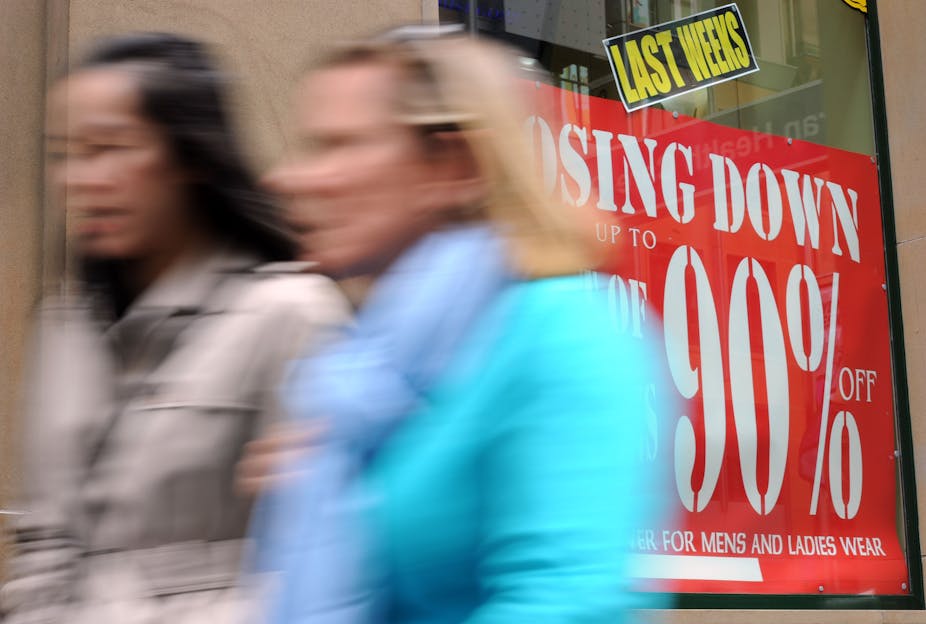Amid the panic that gripped the global markets over past few weeks, there have been some further signs that Australia’s retail sector is in the midst of its own crisis.
Along with a sales slump for department store David Jones and a slight increase in the unemployment rate, came a concerning Productivity Commission report on the state of the retail industry.
The eagerly awaited report presents a mixed view of the industry’s current situation and future prospects, at the same time being both sympathetic yet circumspect.
Retail is suffering the consequences of a perfect storm within the sector – a slow recovery and low growth in the “two-speed” economy, shaky consumer confidence, an increasingly significant propensity for consumers to buy online combined with an exchange rate that makes this especially attractive for overseas purchases.
There have also been rises in the cost of living, resulting in a reduction in discretionary spending. Oversupply in some parts of the market has made discount-based marketing – with its margin implications – the strategy de jour.
Meanwhile, another GFC is potentially waiting in the wings to make things worse.
The report points out that consumers simply aren’t spending as much of their income with retailers as they used to, preferring (or needing) to spend more on health, education, debt clearing and mortgage repayments.
The report acknowledges that there are real challenges facing the industry that potentially compromise productivity, such as zoning and planning issues, Fair Work Act constraints, trading-hour limitations, and tenancy factors.
The Productivity Commission report also highlights retailing’s performance indicator “signature” as trailing other industries. For example, average 2009-10 pre-tax profit margins were at 5.3%, compared with an average of 11.1% across all industries. It also noted a relatively low value-add per person due to high labour intensity and a low-skilled workforce.
In relation to the potential for the industry to perform better, the report asserted that “there may be scope for Australian retail to move towards more efficient practices as in the US and become a stronger contributor to economy-wide productivity growth.”
While direct international performance comparisons are always problematic, it appears that Australian retail remains a fairly ordinary student in “world class” practices. It can do better.
In order for retailers to fully capitalise on the future opportunities that the report presents, it’s timely for the industry to reflect and consider how well it performs across key business disciplines.
No one doubts the passion and enthusiasm of retailers in Australia, but in some areas there is clearly work to do – irrespective of the report’s findings.
Merchandise management, for example, is a central skill area within retail. Unfortunately, many retailers are forced to recruit staff from overseas because domestic senior merchandise management and planning skills – and qualifications – are in short supply.
In terms of service provision, a recent American Express report found that 33% of consumers thought Australian retailers were paying less attention to customer service than in previous years and that 39% of shoppers believed that their “service expectations” were missed.
Crucially, retail remains what can be described as a “periphery profession”, with the Productivity Committee report identifying poor completion rates for retail traineeships compared with other industries. It also raised doubts about whether retail is a “priority” area for potential government intervention in supporting apprenticeships.
While you don’t need a qualification to work in retail management, this is becoming an obvious industry exception compared to more conventional trades and professions like finance, law and real estate, where you qualify for practice rather than relying on “on the job” learning.
After all, what if 20 years experience means you’ve really got one years experience repeated 20 times?.
Finally, it is unclear who is effectively and positively promoting the Australian retail industry story to the people who matter – the consumers.
While the report provides timely insight and identifies an agenda for change for the industry, it’s important that retailers acknowledge at this crucial time that a turning point has been reached.
Retailers need to review, question, learn, challenge, innovate grow, professionalise and do what we know they can do - knuckle down and head for the top of the (world) class.

